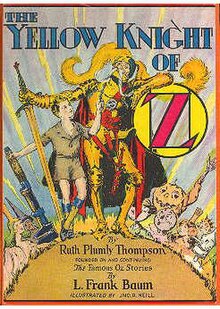
The Wonderful Wizard of Oz is a 1900 children's novel written by author L. Frank Baum and illustrated by W. W. Denslow. It is the first novel in the Oz series of books. A Kansas farm girl named Dorothy ends up in the magical Land of Oz after she and her pet dog Toto are swept away from their home by a cyclone. Upon her arrival in the magical world of Oz, she learns she cannot return home until she has destroyed the Wicked Witch of the West.
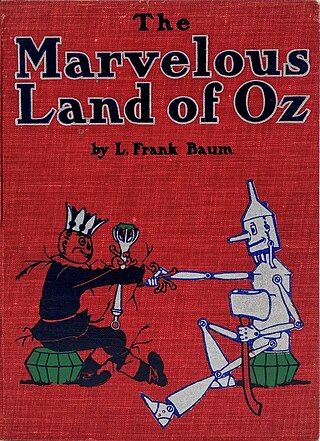
The Marvelous Land of Oz: Being an Account of the Further Adventures of the Scarecrow and the Tin Woodman, commonly shortened to The Land of Oz, published in July 1904, is the second book in L. Frank Baum's Oz series, and the sequel to The Wonderful Wizard of Oz (1900). This and the following 34 books in the series were illustrated by John R. Neill.

Ozma of Oz, published on July 30, 1907, was the third book of L. Frank Baum's Oz series. It was the first in which Baum was clearly intending a series of Oz books.
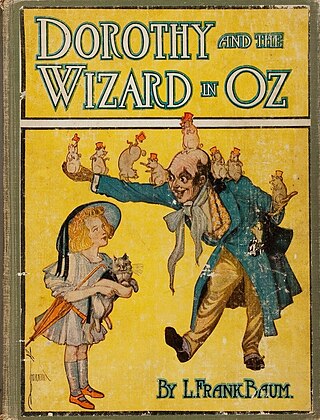
Dorothy and the Wizard in Oz is the fourth book set in the Land of Oz written by L. Frank Baum and illustrated by John R. Neill. It was published on June 18, 1908 and reunites Dorothy Gale with the humbug Wizard from The Wonderful Wizard of Oz (1900). This is one of only two of the original fourteen Oz books to be illustrated with watercolor paintings.

Dorothy Gale is a fictional character created by American author L. Frank Baum as the protagonist in many of his Oz novels. She first appears in Baum's classic 1900 children's novel The Wonderful Wizard of Oz and reappears in most of its sequels. In addition, she is the main character in various adaptations, notably the 1939 film adaptation of the novel, The Wizard of Oz.

Nick Chopper, the Tin Woodman, is a character in the fictional Land of Oz created by American author L. Frank Baum. He first appeared in his 1900 book The Wonderful Wizard of Oz and reappeared in many other subsequent Oz books in the series. In late 19th-century America, men made out of various tin pieces were used in advertising and political cartoons. Baum, who was editing a magazine on decorating shop windows when he wrote The Wonderful Wizard of Oz, was inspired to invent the Tin Woodman by a figure he had built out of metal parts for a shop display.

The Land of Oz is a magical country introduced in the 1900 children's novel The Wonderful Wizard of Oz written by L. Frank Baum and illustrated by W. W. Denslow.

The Royal Book of Oz (1921) is the fifteenth in the series of Oz books, and the first to be written after L. Frank Baum's death. Although Baum was credited as the author, it was written entirely by Ruth Plumly Thompson. Beginning in the 1980s, some editions have correctly credited Thompson, although the cover of the 2001 edition by Dover Publications credits only Baum.
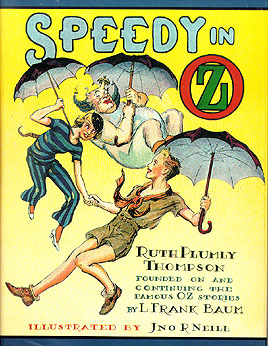
Speedy in Oz (1934) is the twenty-eighth in the series of Oz books created by L. Frank Baum and his successors, and the fourteenth written by Ruth Plumly Thompson. It was illustrated by John R. Neill.

The Hidden Valley of Oz (1951) is the thirty-ninth in the series of Oz books created by L. Frank Baum and his successors. It was written by Rachel R. Cosgrove and illustrated by Dirk Gringhuis.
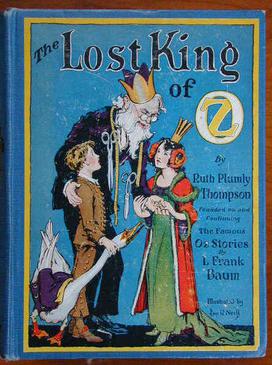
King Pastoria is a fictional character mentioned in the Oz books by American author L. Frank Baum. He was the rightful ruler and King of the undiscovered Land of Oz, but was mysteriously removed from his position when the Wizard of Oz unexpectedly came to the country and took the throne, proclaiming himself as the new dominant ruler of Oz. Shortly after, Pastoria's only child and heir, Princess Ozma, suddenly vanished, leaving not a single clue of her whereabouts.

The Wizard of Oz was a 1902 musical extravaganza based on the 1900 novel The Wonderful Wizard of Oz by L. Frank Baum. Although Baum is the credited bookwriter, Glen MacDonough was hired on as jokewriter after Baum had finished the script, and the book was largely ghostwritten by a man named Finnegan. Much of the original music was by Paul Tietjens and has been mostly lost, although it was still well-remembered and in discussion at MGM in 1939 when the classic film version of the story was made. The original show was particularly popular because of its two comedy stars: Fred Stone playing the Scarecrow, and David C. Montgomery as the Tin Woodman.
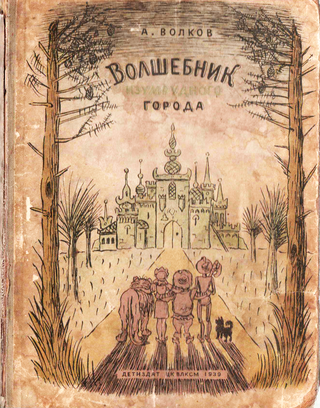
The Wizard of the Emerald City is a 1939 children's novel by Russian writer Alexander Melentyevich Volkov. The book is a re-narration of L. Frank Baum's The Wonderful Wizard of Oz. Baum's name is sometimes credited in the book. The names of most characters are changed, some elements of Baum's novel are removed, and some new elements are added.

The Wonderful Wizard of Oz is a 1900 children's novel written by American author L. Frank Baum. Since its first publication in 1900, it has been adapted many times by L. Frank Baum and others: for film, television, theatre, books, comics, games, and other media.
The Soldier with the Green Whiskers is a character from the fictional Land of Oz who appears in the classic children's series of Oz books by American author L. Frank Baum and his successors. He is introduced in The Wonderful Wizard of Oz (1900). His name is Omby Amby, but this was so obliquely stated that he also became known briefly as Wantowin Battles.
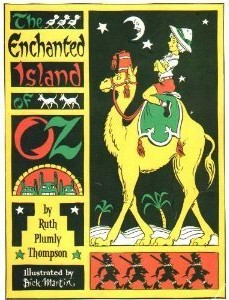
The Enchanted Island of Oz is a children's novel written by Ruth Plumly Thompson and illustrated by Dick Martin, and first published in 1976. The book is an entry in the series of Oz books created by L. Frank Baum and his successors. It is the last of Thompson's 21 novels about the Land of Oz. Written as a standalone novel, unrelated to Oz, around 1948, Thompson revised it as an Oz tale at the request of Oz Club president Fred Meyer.
The copyright status of The Wonderful Wizard of Oz and related works in the United States is complicated for several reasons. The book series is very long-running, and written by multiple authors, so the books often fall on opposite sides of eligibility for copyright laws. There have also been multiple adaptations across many different media, which enjoy different kinds of copyright protection. The copyright law of the United States has changed many times, and impacted Oz works every time. As of 2024, twenty-nine Oz books and five films are in the public domain. Starting in 2019, an Oz book has entered the public domain every year. Barring another extension of copyright terms, all of the Famous Forty will be in the public domain by 2059.
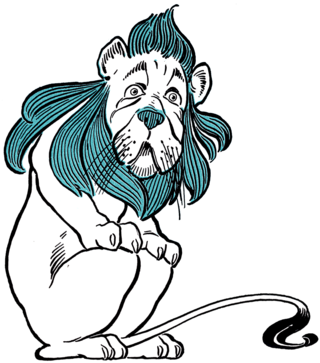
The Cowardly Lion is a character in the fictional Land of Oz created by American author L. Frank Baum. He is depicted as an African lion, but like all animals in Oz, he can speak.
